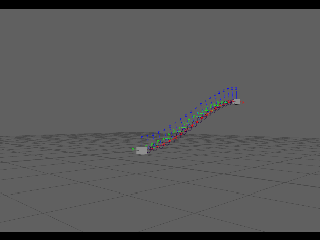2Pnt Hermite Investigation - 01
Maya 2 Point HermiteSpline - Part 01

PREFACE:
Over the last year in my spare time I've been doing some investigations in getting a couple of nodes worked out at home.As it turned out, I haven't had a lot of spare time, as last year the show I was on was pretty challenging time wise etc.
So this year I thought I'd back track a little through my code and wth while I'm at it throw up a post or 2 about what I've been up to re looking into getting these nodes up and running [for better or for worse!]
DISCLAIMER: I'm still pretty new to c++ so I wouldn't rely "too heavily on the code snippets etc. But the nodes are performing/ behaving pretty well at the moment for me.
I should also highlight that I had *NO* idea about hermite stuff before I worked with Raffaele at Animal Logic.
If you're interested in rigging by first principles I highly reccomend you head over to Cult of Rig and watch Raf's streams.
These are packed full of good info and you can flick him a few bucks via patreon to show support!
Why hermite?
Well you can do some pretty cool things with a well written node. Some of the things but not limited to;What was my initial goal?
What were(are) my hurdles?
What is a hermite?
Hermite interpolation is a way to define a curve. We can use this interpolation to create a new type of curve in maya for use in rigging. Therefore;First up I had to look into and try to figure out what the heck a hermite was from a math stand point!
Wikipedia states:
"In numerical analysis, Hermite interpolation, named after Charles Hermite, is a method of interpolating data points as a polynomial function."
But sweet baby jesus it gets confusing fairly quickly on wikipedia.
When looking further into this, I found cubic.org; which states:
"To calculate a hermite curve you need the following vectors:
P1: the startpoint of the curve
T1: the tangent (e.g. direction and speed) to how the curve leaves the startpoint
P2: the endpoint of the curve
T2: the tangent (e.g. direction and speed) to how the curves meets the endpoint
...and the base functions for the hermite are:
h1(t) = 2t^3 - 3t^2 + 1
h2(t) = -2t^3 + 3t^2
h3(t) = t^3 - 2t^2 + t
h4(t) = t^3 - t^2
Note: I changed s to t to represent (t)ime.
These 4 vectors are simply multiplied with 4 hermite basis functions and added together."
Brilliant! Someone broke it down to some fairly straight forward (math) basics. Much <3!!
Essentially, because to begin with I have reduced the problem down to just 2 input points we can start at point1's position in worldSpace and end at point2's position in world space. Thus t0 = p1 and t1 = p2.
So what does this mean for the node?
At it's most basic form, we need to create a node in maya with just 2 inputs...
increment = length / outputCount-1.
This should give us a 2point hermite curve with a UNIFORM distribution of the outputs along the curve.
Seems easy enough!? Right?
[... part02](/c++/2018/04/03/hermite02.html)